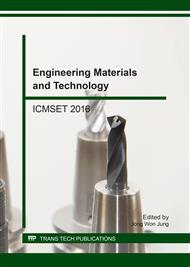[1]
F. Wang, R. Y. Hong, W. G. Feng, D. Badami, K. Zeng, Electrical and mechanical properties of ABS/EPDM composites filled with carbon black. Mater. Lett. 125 (2014) 48–50.
DOI: 10.1016/j.matlet.2014.03.136
Google Scholar
[2]
S. Y. Fu, B. Lauke, Characterization of tensile behavior of hybrid short glass fiber/calcite particle/ABS composites. Comp. Parr. A 29A (1998) 575-583.
DOI: 10.1016/s1359-835x(97)00117-6
Google Scholar
[3]
S. M. Lai, H. C. Li, Y. C. Liao, Properties and preparation of compatibilized nylon 6 Nano composites/ABS blends: Part II – Physical and thermal properties. European Polym. J. 43 (2007) 1660-1671.
DOI: 10.1016/j.eurpolymj.2007.02.009
Google Scholar
[4]
Y. Mohammad, S. N. Masoud, G. Forozan, G. Davood, A. Alireza, Polymeric nanocomposite materials: Synthesis and thermal degradation of acrylonitrile–butadiene–styrene/tin sulfide (ABS/SnS). Inorg. Chem. Acta. 371 (2011) 1–5.
DOI: 10.1016/j.ica.2011.02.020
Google Scholar
[5]
J. Chen, X. C. Du, W. B. Zhang, J. H. Yang, N. Zhang, T. Huang, Y. Wang, Synergistic effect of carbon nanotubes and carbon black on electrical conductivity of PA6/ABS blend. Comp. Sci. Tech. 81 (2013) 1–8.
DOI: 10.1016/j.compscitech.2013.03.014
Google Scholar
[6]
R. Mohammad, E. Mohsen, M. Mehran, Effect of reprocessing on shrinkage and mechanical properties of ABS and investigating the proper blend of virgin and recycled ABS in injection molding. J. Mater. Proc. Tech. 214 (2014) 2359–2365.
DOI: 10.1016/j.jmatprotec.2014.04.028
Google Scholar
[7]
M. F. Xu, S. Lin, X. M. Chen, Y. Z. Peng, Studies on characteristics of Nanostructure of N-TiO2 thin films and photo-bactericidal action. J. Zhejiang Univ. Sci. B. 7(7) (2006) 586-590.
DOI: 10.1631/jzus.2006.b0586
Google Scholar
[8]
L. X. Zhang, X. L. Wang, L. Peng, Z. X. Su, Low Temperature Deposition of TiO2 Thin Film on Polyvinyl Alcohol Fibers with Photocatalytic and Antibacterial Activities. Appl. Surf. Sci. 254(6) (2008) 1771-1774.
DOI: 10.1016/j.apsusc.2007.07.145
Google Scholar
[9]
K. D. Kim, D. N. Han, J. B. Lee, H. T. Kim, Formation and Characterization of Ag Deposited TiO2 Nanoparticles by Chemical Reduction Method. Script. Mater. Lia. 54 (2005) 143-146.
DOI: 10.1016/j.scriptamat.2005.09.054
Google Scholar
[10]
A. R. Bruton, Manufacturing and performance of titanium dioxide ultra-high molecular weight polyethylene nanocomposite materials; MSc thesis; University of Delaware; USA, (2006).
Google Scholar
[11]
L. F. Giraldo, M. Echeverri, B. L. López, Reinforcement of Polyamide 6 with Nanoparticles, Macromolecular Symposium, 258 (2007) 119-128.
DOI: 10.1002/masy.200751214
Google Scholar
[12]
Z. Zhang, J. L. Yang, K. Friedrich, Creep resistant polymeric nanocomposites, Polym. 45 (2004) 3481-3485.
DOI: 10.1016/j.polymer.2004.03.004
Google Scholar
[13]
C. Saujanya, S. Radhakrishnan, Structure development and crystallization behavior of PP/ nanoparticulate composite, Polym. 42 (2001) 6723-6731.
DOI: 10.1016/s0032-3861(01)00140-9
Google Scholar
[14]
Y. Zheng, Y. Zhengb, R. Ning, Effects of nanoparticles SiO2 on the performance of nanocomposites, Mater. Lett. 57 (2003) 2940-2944.
Google Scholar
[15]
S. K. Esthappan, S. K. Kuttappan, R. Joseph, Effect of titanium dioxide on the thermal ageing of polypropylene, Polym. Deg. Stabil. 97 (2012) 615-620.
DOI: 10.1016/j.polymdegradstab.2012.01.006
Google Scholar
[16]
M. K. Akkapeddi, Glass fiber reinforced polyamide-6 nanocomposites, Polym. Compos. 21 (2000) 576-585.
DOI: 10.1002/pc.10213
Google Scholar
[17]
A. Mirigul, Y. Huseyin, Mechanical and Antibacterial Properties of Injection Molded Polypropylene/TiO2 Nano-Composites: Effects of Surface Modification, J. Mater. Sci. Technol. 28(8) (2012) 686–692.
DOI: 10.1016/s1005-0302(12)60116-9
Google Scholar


